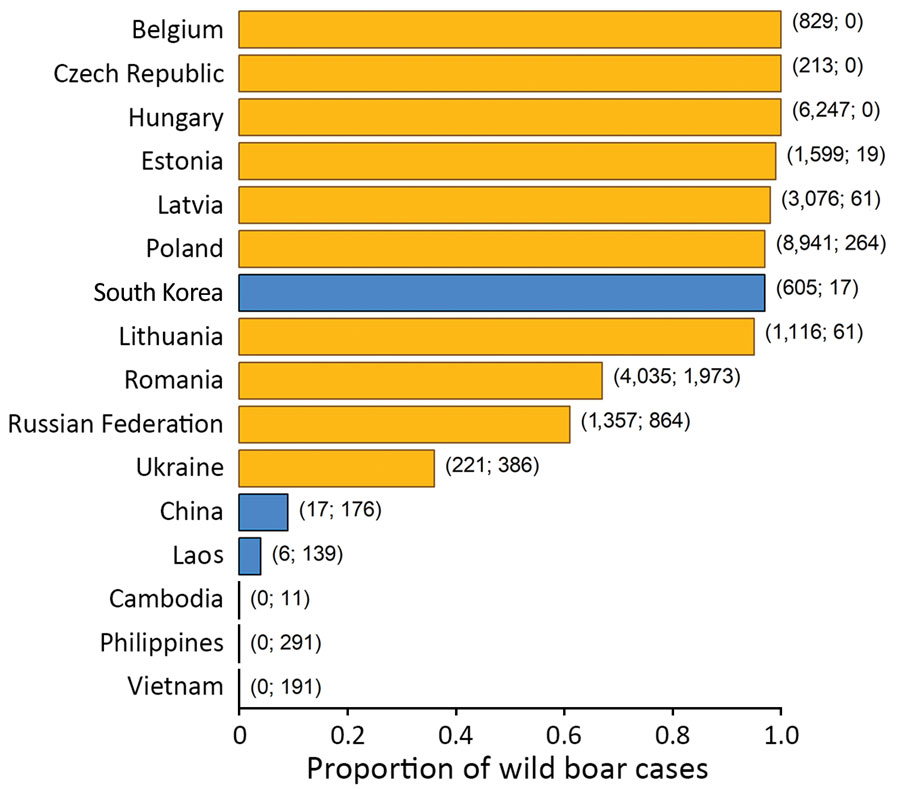Volume 26, Number 10—October 2020
Research Letter
Undetected Circulation of African Swine Fever in Wild Boar, Asia
Figure

Figure. Proportion of wild boar cases out of the total number of reported African swine fever events in the most affected countries in Europe (orange) and Asia (blue). Numbers in parentheses at right side of bars indicate the reported number of wild boar cases and the reported number of outbreaks in farms, from the date of the first reported ASF event in these countries through May 8, 2020 (1).
References
- Food and Agriculture Organization of the United Nations. EMPRES Global Animal Disease Information System [cited 2020 May 8]. http://empres-i.fao.org/eipws3g
- Dixon LK, Stahl K, Jori F, Vial L, Pfeiffer DU. African swine fever epidemiology and control. Annu Rev Anim Biosci. 2020;8:221–46. DOIPubMedGoogle Scholar
- Gavier-Widén D, Ståhl K, Dixon L. No hasty solutions for African swine fever. Science. 2020;367:622–4. DOIPubMedGoogle Scholar
- Chenais E, Ståhl K, Guberti V, Depner K. Identification of wild boar–habitat epidemiologic cycle in African swine fever epizootic. Emerg Infect Dis. 2018;24:810–2. DOIPubMedGoogle Scholar
- Cortiñas Abrahantes J, Gogin A, Richardson J, Gervelmeyer A; European Food Safety Authority (EFSA). Epidemiological analyses on African swine fever in the Baltic countries and Poland. EFSA J. 2017;15:
e04732 .PubMedGoogle Scholar - Vergne T, Chen-Fu C, Li S, Cappelle J, Edwards J, Martin V, et al. Pig empire under infectious threat: risk of African swine fever introduction into the People’s Republic of China. Vet Rec. 2017;181:117. DOIPubMedGoogle Scholar
- Bosch J, Iglesias I, Muñoz MJ, de la Torre A. A cartographic tool for managing African swine fever in Eurasia: mapping wild boar distribution based on the quality of available habitats. Transbound Emerg Dis. 2017;64:1720–33. DOIPubMedGoogle Scholar
- Wu S, Chen H, Cai X. Preliminary study on the population structures and reproductive habit in wild boar (Sus scrofa) in Dawaling Natural Reserve. . Shou Lei Xue Bao. 2000;20:151–6.
- Śmietanka K, Woźniakowski G, Kozak E, Niemczuk K, Frączyk M, Bocian Ł, et al. African swine fever epidemic, Poland, 2014–2015. Emerg Infect Dis. 2016;22:1201–7. DOIPubMedGoogle Scholar
- Liu Q, Yan K, Lu Y, Li M, Yan Y. Conflict between wild boars (Sus scrofa) and farmers: distribution, impacts, and suggestions for management of wild boars in the Three Gorges Reservoir Area. J Mt Sci. 2019;16:2404–16. DOIGoogle Scholar
Page created: June 02, 2020
Page updated: September 17, 2020
Page reviewed: September 17, 2020
The conclusions, findings, and opinions expressed by authors contributing to this journal do not necessarily reflect the official position of the U.S. Department of Health and Human Services, the Public Health Service, the Centers for Disease Control and Prevention, or the authors' affiliated institutions. Use of trade names is for identification only and does not imply endorsement by any of the groups named above.